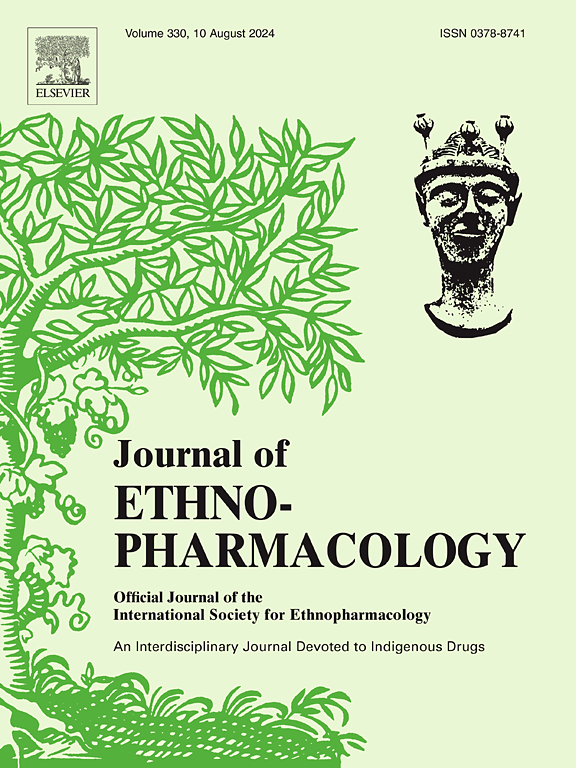淫羊藿及其化学成分在癌症治疗中的应用:传统应用、抗肿瘤作用、药代动力学、传递系统和毒理学的综合综述。
IF 4.8
2区 医学
Q1 CHEMISTRY, MEDICINAL
引用次数: 0
摘要
民族药理学相关性:淫羊藿在中医中被认为是一种补品,以其增强肾阳,强壮肌肉和骨骼,缓解风和湿的作用而闻名。它还具有治疗和预防癌症的特性。本文系统地分析了淫羊藿的植物学、传统用途、主要化学成分、抗肿瘤机制、药代动力学、毒理学和给药系统。在现有研究的基础上,进一步展望淫羊藿的抗肿瘤能力。研究目的:综述淫羊藿的传统抗肿瘤应用及其化学成分的现代药理作用,为进一步阐明淫羊藿的抗肿瘤机制提供有力的理论支持。这也为淫羊藿治疗癌症的研究和开发提供了一个全面的视角。材料和方法:检索中草药资源、PubMed、Web of Science、万方数据库和中国知网(CNKI),对淫羊藿及其成分的抗肿瘤作用进行研究。系统总结和分析淫羊藿治疗肿瘤的实验和临床研究。结果:淫羊藿在中医领域具有治疗癌症的作用。淫淫藿黄酮和多糖除具有传统作用外,还具有抑制肿瘤细胞增殖、诱导细胞凋亡、促进自噬、降低耐药、改善肿瘤免疫微环境(TIM)等作用,可治疗消化系统癌症,如肝癌、结肠癌和胃癌,以及生殖系统癌症,如乳腺癌、宫颈癌和卵巢癌。虽然淫羊藿类黄酮的生物利用度较低,但由于吸收和消除速度快,纳米技术的使用显著提高了靶向抗肿瘤治疗的疗效。然而,淫羊藿在癌症治疗中的作用机制和安全性值得进一步研究。尽管其急性和长期毒性较低,但仍需要进一步的研究来阐明其肝毒性,特别是体内毒性,并进一步探索其在体内的代谢途径、分布和机制。结论:淫羊藿及其化学成分已被证明具有抑制肿瘤发生和发展的作用,但需要进一步的临床研究来验证这些发现。尽管淫羊藿具有潜力,但目前对其的研究仍有很大的局限性,需要对其有效的生物活性成分、潜在的药理作用和给药方法进行更全面的研究。本文章由计算机程序翻译,如有差异,请以英文原文为准。

Epimedium and its chemical constituents in cancer treatment: A comprehensive review of traditional applications, antitumor effects, pharmacokinetics, delivery systems, and toxicology
Ethnic pharmacological relevance
Epimedium, recognized within traditional Chinese medicine (TCM) as a tonic, is noted for its role in enhancing kidney Yang, fortifying muscles and bones, and alleviating wind and dampness. It also exhibits therapeutic and preventive properties against cancer. This study systematically analyzes the botany, traditional uses, principal chemical components, antitumor mechanisms, pharmacokinetics, toxicology, and drug delivery systems of Epimedium. It aims to further prospect the antitumor capabilities of Epimedium based on existing research.
Aim of the study
This review aims to explore the traditional antitumor applications of Epimedium and the contemporary pharmacological actions of its chemical components, providing robust theoretical support for further elucidating Epimedium's antitumor mechanisms. It also offers a comprehensive view for the research and development of cancer treatments involving Epimedium.
Materials and methods
We conducted searches in classical Chinese herbal medicine resources, PubMed, Web of Science, Wanfang Database, and China National Knowledge Infrastructure (CNKI) for studies on the antitumor effects of Epimedium and its components. Existing experimental and clinical studies were systematically summarized and analyzed to understand the mechanisms by which Epimedium treats cancer.
Results
In the realm of Chinese medicine, Epimedium is recognized for its cancer-treating capabilities. Besides its traditional effects, flavonoids and polysaccharides from Epimedium can inhibit tumor cell proliferation, induce apoptosis, promote autophagy, reduce drug resistance, and improve the tumor immune microenvironment (TIM), addressing cancers of the digestive system, such as liver, colon, and gastric cancers, and of the reproductive system, including breast, cervical, and ovarian cancers. Although the bioavailability of Epimedium flavonoids is low due to rapid absorption and elimination, the use of nanotechnology has significantly enhanced the efficacy of targeted antitumor therapies. Nevertheless, the mechanisms and safety of Epimedium in cancer treatment merit further investigation. Despite its low acute and long-term toxicity, additional research is required to clarify its hepatotoxicity, particularly in vivo, and to further explore its metabolic pathways, distribution, and mechanisms within the body.
Conclusion
Epimedium and its chemical constituents have been shown to inhibit tumor initiation and progression, however, further clinical studies are required to validate these findings. Despite its potential, significant limitations remain in the current research on Epimedium, necessitating more comprehensive studies on its potent bioactive components, potential pharmacological effects, and administration methods.
求助全文
通过发布文献求助,成功后即可免费获取论文全文。
去求助
来源期刊

Journal of ethnopharmacology
医学-全科医学与补充医学
CiteScore
10.30
自引率
5.60%
发文量
967
审稿时长
77 days
期刊介绍:
The Journal of Ethnopharmacology is dedicated to the exchange of information and understandings about people''s use of plants, fungi, animals, microorganisms and minerals and their biological and pharmacological effects based on the principles established through international conventions. Early people confronted with illness and disease, discovered a wealth of useful therapeutic agents in the plant and animal kingdoms. The empirical knowledge of these medicinal substances and their toxic potential was passed on by oral tradition and sometimes recorded in herbals and other texts on materia medica. Many valuable drugs of today (e.g., atropine, ephedrine, tubocurarine, digoxin, reserpine) came into use through the study of indigenous remedies. Chemists continue to use plant-derived drugs (e.g., morphine, taxol, physostigmine, quinidine, emetine) as prototypes in their attempts to develop more effective and less toxic medicinals.
 求助内容:
求助内容: 应助结果提醒方式:
应助结果提醒方式:


